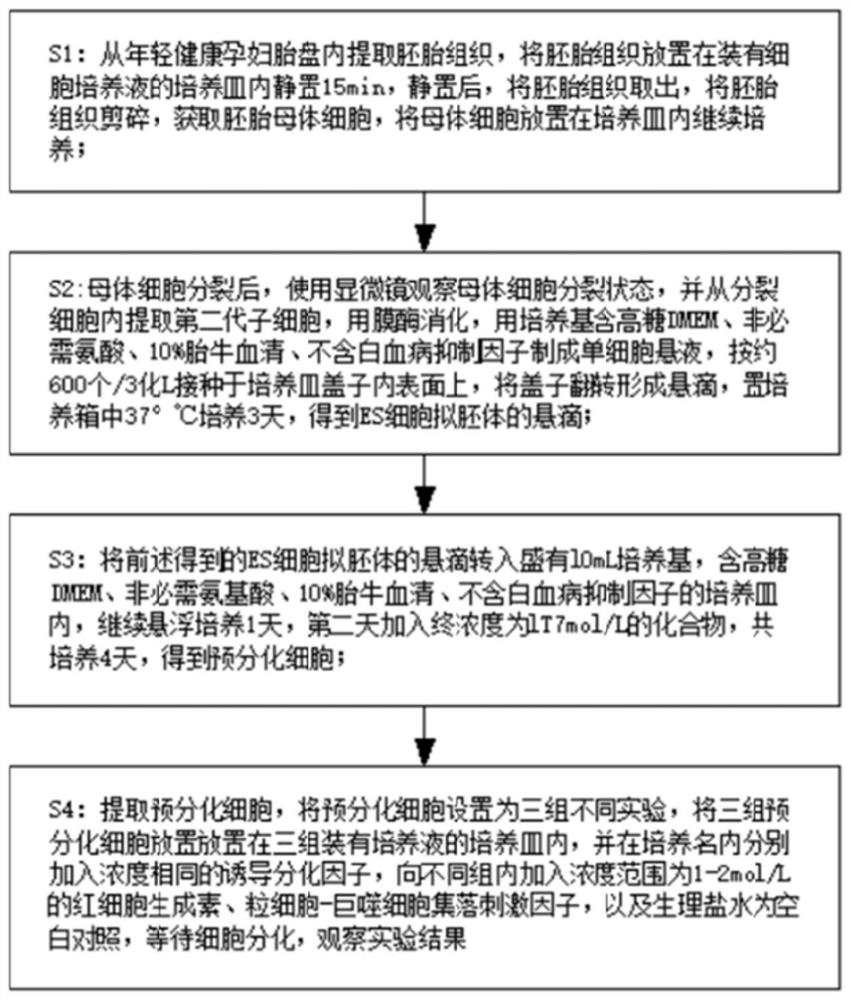Stem cell directional differentiation and cell transdifferentiation method
A directional differentiation, stem cell technology, applied in the field of stem cell research, can solve the problem of no in-depth research on directional differentiation of stem cells
- Summary
- Abstract
- Description
- Claims
- Application Information
AI Technical Summary
Problems solved by technology
Method used
Image
Examples
Embodiment 1
[0026] A method for directed differentiation of stem cells and cell transdifferentiation, comprising the following steps:
[0027] Step 1: Extract embryonic tissue from the placenta of young healthy pregnant women, place the embryonic tissue in a culture dish filled with cell culture medium and let it stand for 15 minutes. , placing the maternal cells in a petri dish to continue culturing;
[0028] Step 2: After the division of the mother cells, use a microscope to observe the division state of the mother cells, and extract the second-generation daughter cells from the division cells, digest them with trypsin, and use a medium containing high-sugar DMEM, non-essential amino acids, and 10% fetal bovine serum , do not contain leukemia inhibitory factor to make a single cell suspension, inoculate about 600 cells / 3L on the inner surface of the lid of the culture dish, turn the lid over to form a hanging drop, and culture it in an incubator at 37°C for 3 days to obtain ES Hanging ...
Embodiment 2
[0034] A method for directed differentiation of stem cells and cell transdifferentiation, comprising the following steps:
[0035] Step 1: Extract embryonic tissue from the placenta of young healthy pregnant women, place the embryonic tissue in a culture dish filled with cell culture medium and let it stand for 15 minutes. , placing the maternal cells in a petri dish to continue culturing;
[0036] Step 2: After the division of the mother cells, use a microscope to observe the division state of the mother cells, and extract the second-generation daughter cells from the division cells, digest them with trypsin, and use a medium containing high-sugar DMEM, non-essential amino acids, and 10% fetal bovine serum , do not contain leukemia inhibitory factor to make a single cell suspension, inoculate about 600 cells / 3L on the inner surface of the lid of the culture dish, turn the lid over to form a hanging drop, and culture it in an incubator at 37°C for 3 days to obtain ES Hanging ...
Embodiment 3
[0042] A method for directed differentiation of stem cells and cell transdifferentiation, comprising the following steps:
[0043] Step 1: Extract embryonic tissue from the placenta of young healthy pregnant women, place the embryonic tissue in a culture dish filled with cell culture medium and let it stand for 15 minutes. , placing the maternal cells in a petri dish to continue culturing;
[0044] Step 2: After the division of the mother cells, use a microscope to observe the division state of the mother cells, and extract the second-generation daughter cells from the division cells, digest them with trypsin, and use a medium containing high-sugar DMEM, non-essential amino acids, and 10% fetal bovine serum , do not contain leukemia inhibitory factor to make a single cell suspension, inoculate about 600 cells / 3L on the inner surface of the lid of the culture dish, turn the lid over to form a hanging drop, and culture it in an incubator at 37°C for 3 days to obtain ES Hanging ...
PUM
 Login to View More
Login to View More Abstract
Description
Claims
Application Information
 Login to View More
Login to View More - R&D
- Intellectual Property
- Life Sciences
- Materials
- Tech Scout
- Unparalleled Data Quality
- Higher Quality Content
- 60% Fewer Hallucinations
Browse by: Latest US Patents, China's latest patents, Technical Efficacy Thesaurus, Application Domain, Technology Topic, Popular Technical Reports.
© 2025 PatSnap. All rights reserved.Legal|Privacy policy|Modern Slavery Act Transparency Statement|Sitemap|About US| Contact US: help@patsnap.com


